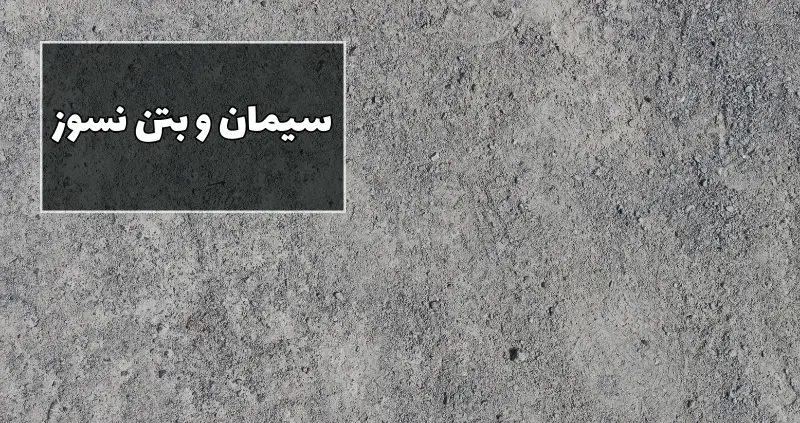
Since the distant past, mankind has been trying to make resistant and durable building materials against harsh environmental conditions such as heat and fire. These efforts have led to the emergence of an important field of construction materials called “refractory cement and concrete”. These materials have many applications in heat-sensitive industries such as steelmaking, glassmaking, ceramics, and petrochemicals. Despite the technical challenges in production, unique advantages such as amazing resistance to very high temperatures, chemical stability and superior mechanical properties have made cement and refractory concrete an essential choice in the design and construction of industrial equipment and structures. Traveling to the fascinating world of these widely used materials will be a way to a deeper understanding of modern technologies and innovations in the field of material engineering and construction.
Types of refractory cement
Alumina cement:
Alumina cement is one of the most common and widely used types of refractory cement. This cement is mainly composed of crystallized alumina (Al2O3) and additives such as iron oxide. Alumina cement has excellent resistance to heat, acids and wear and can maintain its stability at temperatures above 1600 degrees Celsius. For this reason, it is widely used in industries such as steelmaking, ceramics and glassmaking.
Silicate cement:
Silicate cement or rusty cement is composed of silica materials such as calcium silicate, calcium aluminate and iron oxides. This type of refractory cement is highly resistant to alkaline environments and is used in cement kilns, chemical industries and metallurgy. Although it has lower heat resistance than alumina cement, it has a lower production cost.
Phosphate cement:
Phosphate cement is made from the combination of aluminum oxides and aluminum phosphate. This cement is suitable for special applications in highly acidic environments such as sulfuric and phosphoric acid production factories. In addition, it has relatively good anti-wear properties and heat resistance. However, its high production cost and limited application make it a more specialized option among refractory cement types.
Types of refractory concrete
Aluminous concrete:
Alumina concrete consists of a mixture of alumina cement, refractory aggregates (such as alumina, dolomite or silica sand) and special additives. This type of refractory concrete has excellent resistance to heat, thermal shock, acids and wear. Alumina concrete maintains its stability at temperatures above 1600 degrees Celsius, and for this reason, it is widely used in steelmaking, casting and ceramic industries.
Silicate concrete:
Silicate concrete is made from a mixture of silicate cement, silica refractory aggregates and complementary additives. In addition to good heat resistance, this type of concrete also has excellent resistance to alkaline and corrosive environments. Silicate concrete is used in cement, glass, metallurgy and petrochemical industries and has a lower production cost than alumina concrete.
Phosphate concrete:
Phosphate concrete is formed on the basis of phosphate cement and acid-resistant aggregates such as quartz or silica. This type of concrete is especially suitable for use in highly acidic environments such as sulfuric and phosphoric acid production factories. Phosphate concrete has very good chemical and thermal resistance, but the high production cost makes it a more specialized option among all types of refractory concrete.
Raw materials and production process
Alumina cement raw materials:
For the production of alumina cement, the main raw materials include bauxite (aluminum ore), crystallized alumina, iron oxide, calcium oxide and gypsum. Bauxite is the main source of aluminum, which is converted into pure alumina after the Bayer process. Iron oxide is used to increase the resistance of cement against acids, and calcium oxide and gypsum are also used as additives to adjust the setting time of cement.
Silicate cement raw materials:
Silicate cement consists of raw materials such as limestone, clay, silica and iron oxide. Limestone is the main source of calcium, clay is the source of aluminum and silica. Iron oxide is also used as an additive to increase the chemical resistance of cement. Different proportions of these materials are mixed depending on the desired type of silicate cement.
Raw materials of refractory concrete:
Refractory concrete consists of a combination of refractory cement, refractory aggregates and special additives. Refractory aggregates usually include alumina, dolomite, silica sand, quartz, and silica. Additives are also used to improve the properties of concrete, such as reducing water loss, increasing fluidity, and accelerating or delaying its setting.
Alumina cement production process:
Production of alumina cement includes crushing and grinding of raw materials, calcination (heating at high temperature) and final grinding. First, the raw materials are crushed and ground to become a soft powder. Then this powder is calcined in rotary kilns at a temperature of about 1600 degrees Celsius so that the necessary chemical reactions occur. Finally, the resulting clinker is ground and converted into the final alumina cement by adding gypsum.
Refractory concrete production process:
To produce refractory concrete, first refractory cement, aggregates and desired additives are mixed in a heavy mixer. Then water is added to the mixture and the mixing continues until a homogeneous paste is obtained. This dough is poured into the desired molds and after initial setting, it is baked at high temperature to complete the necessary chemical reactions. Finally, refractory concrete is ready to be used in various applications after cooling.
Physical and chemical properties
mechanical properties:
Cement and refractory concrete have very favorable mechanical properties. They usually have a high compressive and bending strength of about 50 to 150 megapascal have. This feature allows them to be resistant to harsh working conditions such as pressure and impact forces caused by industrial processes. In addition, cement and refractory concrete have good adhesion with metals, which is important in casting applications.
thermal resistance:
One of the most important features of cement and refractory concrete is their extraordinary resistance to very high temperatures. Alumina cement can maintain its stability up to 1800 degrees Celsius and silicate cement up to 1500 degrees Celsius. This feature makes them suitable for use in industries such as steelmaking, casting, ceramics, etc.
Chemical resistance:
Refractory cement and concrete have very good chemical resistance against acids, bases and corrosive environments. For example, alumina cement is very resistant to mineral acids such as sulfuric acid and hydrochloric acid. Silicate cement also shows good stability against strong alkaline environments. This feature makes them suitable for use in chemical and petrochemical industries.
Thermal shock resistance:
Thermal shock is one of the main challenges in industrial applications. Refractory cement and concrete have good resistance against sudden thermal shocks due to their low coefficient of thermal expansion and good thermal conductivity. This feature prevents cracking and damage during sudden temperature changes.
Other properties:
In addition to the mentioned properties, cement and refractory concrete have other properties. Among others, we can mention resistance to wear, low electric current, suitable thermal insulation and resistance to oxidation at high temperatures. These properties make them suitable for various applications in different industries.
Know more: silica sand
Applications of cement and refractory concrete
Steelmaking and metal casting industries:
One of the main applications of cement and refractory concrete is in steelmaking and metal casting industries. These materials are used to cover the walls of metal melting furnaces, casting beds, casting molds and other equipment exposed to very high temperatures and harsh working conditions. Their extraordinary heat resistance and suitable chemical properties increase the lifespan of these equipments and prevent production stoppages.
Chemical and petrochemical industries:
In the chemical and petrochemical industries, cement and refractory concrete are used to build reactors, chemical storage tanks, protective walls and other equipment exposed to corrosive substances and high temperatures. The chemical and thermal resistance of these materials prevents equipment damage and guarantees the safety and stability of industrial processes.
Ceramic and glass industries:
In ceramic and glass factories, cement and refractory concrete are used to make thermal furnaces, forming molds and other equipment related to heating and melting raw materials. The excellent properties of these materials against very high temperatures, thermal shocks and corrosive environments increase the efficiency, useful life and stability of these equipments.
Power plants and industrial furnaces:
In thermal power plants, industrial heating furnaces and other similar applications, cement and refractory concrete are used to cover the inner walls of burners, chimneys, combustion chambers and other parts exposed to flame and hot gases. The high thermal resistance and chemical stability of these materials prevent damage caused by harsh working conditions.
Other industrial and non-industrial applications:
In addition to the mentioned applications, cement and refractory concrete are also used in other fields. Among others, we can mention floor construction and floor covering in heavy industries, making household fire products such as fireplaces and grills, fire resistant structures, covering missiles and heat shields. Wherever there is a need to withstand extreme heat and harsh environmental conditions, cement and refractory concrete are an ideal and efficient option.
